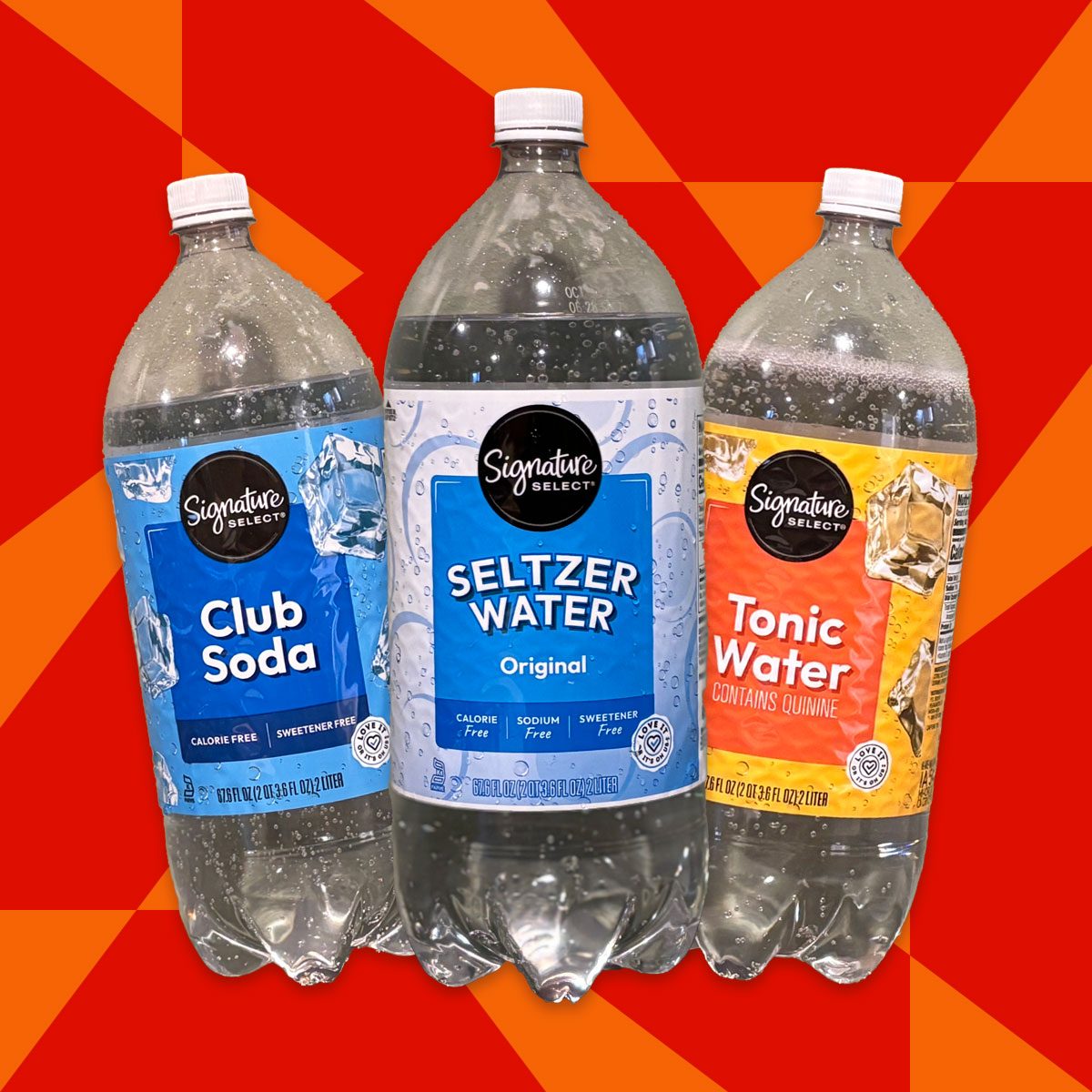It's easy to confuse these bubbly beverages. Here's what makes each one unique, and the best time to use each one.

Seltzer Water vs. Club Soda vs. Tonic Water: What’s the Difference?

It’s easy to tell Coke from Dr Pepper from Mountain Dew. But when you wander down the aisle of mixers and waters at your local store, things get a bit more confusing. When faced with a wall of 2-liter bottles filled with clear liquids, can you tell seltzer water from club soda from tonic water from sparkling water? While all of them are carbonated beverages (meaning they contain dissolved carbon dioxide gas, which can occur naturally or be added by a production process), some are ideal for cocktails and mixing while others are best for thirst-quenching sipping. It’s helpful to know the difference.
What is seltzer water?
Seltzer water is simply water that has been carbonated. Carbonation forms the tiny bubbles in soda and other drinks, giving them their fizzy, sparkling charm. You can even buy an at-home carbonator to make your own and save big bucks.
The term “seltzer water” derives from Selters, a German town renowned for its mineral springs. Americans tend to use the terms seltzer water and soda water interchangeably.
Seltzer water has a storied place in American pop culture. That’s mostly because of the large siphon seltzer bottles that were made to dispense it. They became a cliche of slapstick and clown scenes, where the characters would race around and spray the pressurized seltzer water at each other for laughs. If you’ve seen the famous “Mary Tyler Moore Show” episode about Chuckles the Clown, you know that she finally loses her cool and dissolves into laughter when the minister recalls Chuckles’ favorite saying, “a little song, a little dance, a little seltzer down your pants.”
It’s also a key ingredient in the classic New York egg cream, a specialty of soda fountains and delicatessens. Despite its name, the drink has no eggs or cream—it’s made with whole milk, chocolate syrup and seltzer.
Is seltzer water bad for you?
Somewhere along the line, seltzer water gained an unfair reputation for being harmful. (Maybe it was all those clowns getting drenched.) Seltzer water, like all water, keeps you hydrated and helps you feel full. If you do have acid reflux issues, you might want to steer clear of a lot of carbonation because it could make those symptoms worse, but seltzer is otherwise harmless, despite its bad rap.
What is club soda?
Club soda has the coolest name of the bunch, taking its name from the Kindare Street Club in Dublin, Ireland. The club commissioned Irish company Cantrell & Cochrane to produce the drink back in 1877. Like seltzer, club soda is carbonated, but it usually contains added minerals. One club soda bottle I recently picked up listed its ingredients as carbonated water and sodium citrate, which is the sodium salt of citric acid.
What is tonic water?
Fans of the classic gin and tonic will already be familiar with tonic water and its pleasantly bittersweet taste. Tonic water is essentially a quinine-flavored carbonated soft drink. Quinine is a compound found in the bark of the South American cinchona tree. (The name of the British mixer brand Fever Tree pays homage to these trees and their bark, which has medicinal properties and was used as an early treatment for malaria.)
Tonic is a favorite as a bar mixer, for vodka tonics as well as gin and tonics. It can be spiked with lemon or lime juice to make bitter lemon or bitter lime, respectively. And more and more coffee shops in the US are selling espresso and tonic, which is a Swedish-invented drink sometimes sweetened with a flavored syrup. If you see it on the menu at your local coffee shop, give it a try—it’s not for everyone, but I rather like it.
What is sparkling water?
Sparkling water contains added carbonation and, sometimes, minerals or flavors. We taste-tested sparkling water brands to find the best. Bubly, LaCroix, Spindrift, Dasani and Waterloo are just a few of the brands you’ve almost certainly seen on store shelves.
Some online sources will tell you that seltzer is artificially carbonated, while sparkling water is naturally carbonated. Maybe that was once true, but the sparkling water I bought had a huge banner on it saying, “carbonation added.”
So next time a waiter at a fancy restaurant takes your water order, asking, “Sparkling or still?” you’ll know how to respond.
Seltzer Water vs. Club Soda vs. Tonic Water vs. Sparkling Water

While these four waters may look the same, they all have different purposes and tastes. Tonic water is obviously in a class of its own with the addition of sugar and bitter quinine, and it’s a must-buy if you keep a stocked home bar. Seltzer water isn’t what I’d call thirst-quenching; it’s a bit too mineral-forward for me. I find club soda crisper and cleaner than seltzer. When I go out and don’t want to have anything alcoholic, a club soda with fresh lime is often my pick. Sparkling water is the most thirst-quenching of the four. I bought a plain variety for comparison’s sake and definitely noticed the mineral flavor. That’s usually hidden by the fruit flavors I tend to buy.
My house is always well-stocked with sparkling water, since we try to stay hydrated without overdoing it on soda. There are so many sparkling water flavors to choose from, we never get tired of one particular variety. And we use our SodaStream to make seltzer whenever we want a plain fizzy water choice. I thought we were making club soda, honestly, but now that I know club soda contains added minerals, I guess we were making seltzer all along!
You don’t really need all four of the waters in your home at any one time. Keep some flavored sparkling water handy—and tonic if you’re a cocktail drinker—and you’ll likely be set for most occasions.



















